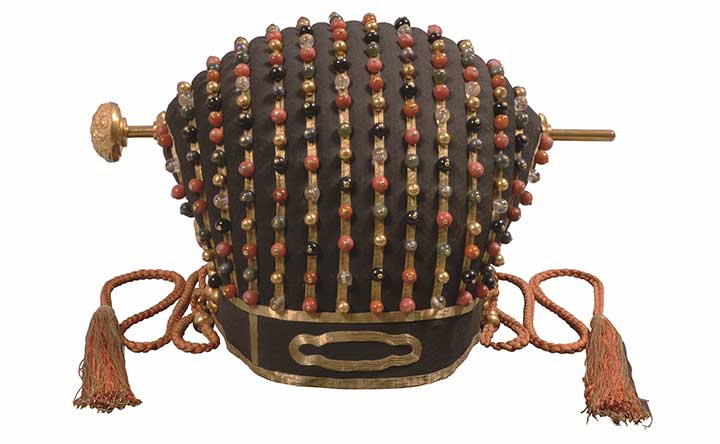

Tue, May 3, 2022
(This exhibition has moved to its next venue in Fukuoka Prefecture)
A special exhibition featuring the art and culture of Okinawa (formerly Ryukyu Kingdom) has opened today (May 3, 2022) at the Tokyo National Museum in Ueno Park. About 390 cultural assets — including 72 designated national treasures and 22 designated important cultural properties — associated with Japan’s southernmost prefecture will go on display, making it the largest exhibit ever of its kind in the nation’s capital.

The RYUKYU exhibition is held in association with the Tsumugu Project — a joint effort of Japan’s Cultural Affairs Agency, Imperial Household Agency and The Yomiuri Shimbun (a national daily newspaper based in Tokyo) to help preserve the nation’s artistic treasures — and co-organized by the Okinawa Prefectural Museum and Art Museum in Naha to commemorate the 50th anniversary of Okinawa’s reversion to Japan*.
Special Exhibition:
Commemorating the 50th Anniversary of Okinawa’s Reversion to Japan
RYUKYU
May 3 (Tue) – Jun 26 (Sun), 2022
Tokyo National Museum
(Ueno Park, Tokyo)
*See outline below for more info
A cultural sphere developed in an area comprising today’s Okinawa Prefecture and Amami Islands (Kagoshima Prefecture) in the 11th-12th century, which later formed an independent kingdom ruled by the Ryukyuan monarchy. The kingdom lasted from the 15th century to the 19th century, until it became an integral part of Japan. The exhibit gives visitors a brief overview of Ryukyu’s history as it takes them on a tour of the various relics of the kingdom, which over time have become Japan’s artistic and cultural treasures.

In the first chapter of the exhibition (“Bridging Nations, Connecting Asia”), for instance, the 15th-century “Bridge of Nations” bell (formerly located in the main hall of Shuri Castle), a government-designated important cultural property, is introduced as having served as the symbol of prosperity in Ryukyu, which flourished as a maritime kingdom.
In chapter II (“Diplomacy and Culture”), the Ryukyuan letter of appointment (from the Dana family documents) issued during the reign of the Second Sho Dynasty and some other items on view are labeled as “symbols of royal power.” The Ryukyuan letter is also a designated important cultural property.

The exhibition then leads you to the prehistoric culture of the Ryukyu islands in chapter III, focuses on their religion in chapter IV, and moves on to their future in chapter V, the last segment.
Visitors will likely be astounded when they step into section C of chapter II, where a number of Second Sho Dynasty treasures are on display. Every garment, furnishing, tableware or sword you see in the room are Japan’s designated national treasures. Visitors are allowed to take photos (for personal use) in section C and in this section only.

Other items on view in the exhibit include:
— Red stemmed cup with a stand (Second Sho Dynasty, 18th-19th century), a designated national treasure (chapter II)
— Black wakizashi sword known as “Jiganemaru” (blade: Muromachi period, 16th century; Mounting: Edo period, 17th century), a designated national treasure (chapter II)
— Shell spoons from the Kominato Fuwaganeku site in Amami, Kagoshima Pref. (Late Shell Mound period, 6th-7th century), a designated important cultural property (chapter III)
— Kamiogi folding fan (Edo period or Second Sho Dynasty, 19th century; chapter IV)
— Black partitioning screen depicting Shuri and Naha Port (Showa era, 1928; chapter V)

The special exhibition will last until June 26, 2022, in Tokyo, and later move on to Kyushu National Museum in Dazaifu, Fukuoka Pref.


From the museum website:
2022 marks the 50th anniversary of Okinawa’s reversion to Japan. Once a kingdom named Ryukyu with a unique history and culture, Okinawa began modernizing in the Meiji era (1868–1912) and later suffered hardships because of the Second World War. However, it has continuously striven to pass its history and culture down to future generations. Through fascinating cultural properties, this comprehensive exhibition explores the founding of the Ryukyu Kingdom in Asia, the formation and legacy of its unique culture, and the region’s postwar recovery.
Tokyo National Museum is home to one of Japan’s largest collections of works associated with Ryukyu. Many were purchased from Okinawa Prefecture during the Meiji era while others were later donated to the Museum. The Museum conducts research on Ryukyu’s history and culture, and shares its findings through exhibitions. An iconic example of its efforts was the special exhibition History and Culture of Okinawa Islands, which was held at the Museum in 1992, the 20th anniversary of Okinawa’s reversion to Japan. Building on this past success, RYUKYU is the largest exhibition about the magnificent history and culture of this region.

Outline of the event
Schedule
Tue, May 3, 2022〜Sun, Jun 26, 2022
Special Exhibition:
Commemorating the 50th Anniversary of Okinawa's Reversion to Japan
RYUKYU
9:30 a.m. - 5:00 p.m.
(Last admission 4:30 p.m.)
Tokyo National Museum
(Heiseikan)
13-9 Ueno-koen
Taito Ward, Tokyo
*10-min. walk from Ueno station
Adults: 2,100 yen
University students: 1,300 yen
High school students: 900 yen
Junior high school students and under: Free
*Persons with disabilities are admitted free with 1 accompanying person each (ID required at ticket booth)
Closing day
Mondays
Contact
Tel. 050-5541-8600
0%